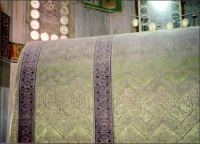Pelbegu
The history of the Rangkuti & Pulungan clan states that the origin of the Batak Mandailing tribe is from the lower reaches of the Batang Gadis River. This is also based on the history of the clan in this tribe which relates the life of their ancestors to this river. The Kingdom's territory stretched from Portibi to Panyabungan.
Together with Sutan Puasa, they were involved in the Klang War between 1866-1873. In the mid-19th century, the Dutch established defensive forts at Singengu & Kotanopan. Some other people have migrated to Riau, to the Malay Peninsula.
A small portion of this ethnic group also lives in Selangor & Perak, Peninsular Malaysia. They were once under the influence of the Padri from Minangkabau, so culturally this ethnic group was influenced by Islamic religious culture. Like the majority of Indonesian people, this ethnic group adheres to the Syafii school of thought.
Before getting to know Islam, this tribe already had a belief known as the animist / Pelbegu belief system. Begu itself in Batak language means spirits. The Pelbegu belief system is to worship the spirits of ancestors.
There is also the name Begu Tagasan which is believed by this tribe to protect one descendant and one clan. Begu Boru Ni Namora Nam Puna Tano is a noble Princess. Begu Boru Ni Ambolungan Bulu Begu Na Pahae Paulu in Batang Aek is the owner of the river/water.
Begu Tuan Jonjang Balentung Na Mian in Pangulu Balang is the one that occupies the guardian statue. Among the Batak tribe, there is a very well-known begu, namely Begu Ganjang. Some Batak people believe that this begu is the guardian of someone's land/property, where if we disturb the land/property of the landlord we will be exposed to danger such as serious illness, and could even result in death.
According to the beliefs of this tribe in the period before the arrival of Islam, all the begu worshiped & revered by the people of this tribe had one almighty figure called Na Gumorga Langit Na Tumompa Tano. Thus, several elders in this tribe once stated that in the old Pelbegu belief system, 2 main figures had quite important roles, namely Si Baso & Bayo Datu. Si Baso is believed to be an intermediary medium for communicating with the supernatural world to ask for help & assistance because Si Baso can communicate with the spirits of ancestors.
To communicate with spirits, a ritual ceremony will be held. This ritual is carried out so that Baso can be possessed by the spirits of his ancestors. The spirits of the ancestors will provide guidance to overcome various problems & disasters that are befalling residents.
This ritual will be led & directed by Datu. In general, megalithic culture/traditions which are often associated with animist beliefs, some of which are mixed with remnants of Hindu-Buddhist beliefs, have long disappeared from the life of this community, along with the influence of Islam. Because before the Padri entered and finally controlled this tribe, the population adhered to animism called Pelbegu.
In line with that, everything that smelled of animism quickly disappeared from the life of this society & was replaced by Islam.




Comments
Post a Comment